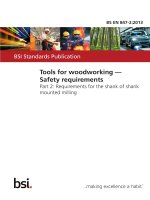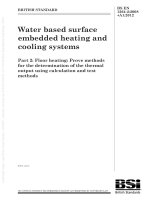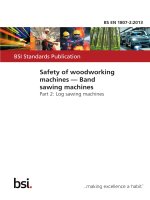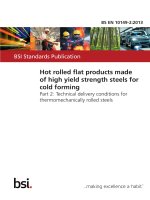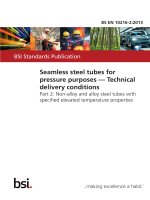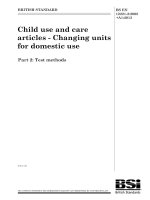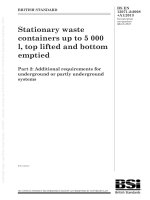Bsi bs en 12316 2 2013
Bạn đang xem bản rút gọn của tài liệu. Xem và tải ngay bản đầy đủ của tài liệu tại đây (899.52 KB, 14 trang )
BS EN 12316-2:2013
BSI Standards Publication
Flexible sheets for
waterproofing —
Determination of peel
resistance of joints
Part 2: Plastic and rubber sheets for roof
waterproofing
BS EN 12316-2:2013
BRITISH STANDARD
National foreword
This British Standard is the UK implementation of EN 12316-2:2013.
It supersedes BS EN 12316-2:2000 which is withdrawn.
The UK participation in its preparation was entrusted to Technical
Committee B/546, Flexible sheets for waterproofing and water
vapour control.
A list of organizations represented on this committee can be
obtained on request to its secretary.
This publication does not purport to include all the necessary
provisions of a contract. Users are responsible for its correct
application.
© The British Standards Institution 2013. Published by BSI Standards
Limited 2013
ISBN 978 0 580 80228 7
ICS 91.100.50
Compliance with a British Standard cannot confer immunity from
legal obligations.
This British Standard was published under the authority of the
Standards Policy and Strategy Committee on 30 June 2013.
Amendments issued since publication
Date
Text affected
BS EN 12316-2:2013
EN 12316-2
EUROPEAN STANDARD
NORME EUROPÉENNE
EUROPÄISCHE NORM
June 2013
ICS 91.100.50
Supersedes EN 12316-2:2000
English Version
Flexible sheets for waterproofing - Determination of peel
resistance of joints - Part 2: Plastic and rubber sheets for roof
waterproofing
Feuilles souples d'étanchéité - Détermination de la
résistance au pelage des joints - Partie 2 : Feuilles
d'étanchéité de toiture plastiques et élastomères
Abdichtungsbahnen - Bestimmung des Schälwiderstandes
der Fügenähte - Teil 2: Kunststoff- und Elastomerbahnen
für Dachabdichtungen
This European Standard was approved by CEN on 28 March 2013.
CEN members are bound to comply with the CEN/CENELEC Internal Regulations which stipulate the conditions for giving this European
Standard the status of a national standard without any alteration. Up-to-date lists and bibliographical references concerning such national
standards may be obtained on application to the CEN-CENELEC Management Centre or to any CEN member.
This European Standard exists in three official versions (English, French, German). A version in any other language made by translation
under the responsibility of a CEN member into its own language and notified to the CEN-CENELEC Management Centre has the same
status as the official versions.
CEN members are the national standards bodies of Austria, Belgium, Bulgaria, Croatia, Cyprus, Czech Republic, Denmark, Estonia,
Finland, Former Yugoslav Republic of Macedonia, France, Germany, Greece, Hungary, Iceland, Ireland, Italy, Latvia, Lithuania,
Luxembourg, Malta, Netherlands, Norway, Poland, Portugal, Romania, Slovakia, Slovenia, Spain, Sweden, Switzerland, Turkey and United
Kingdom.
EUROPEAN COMMITTEE FOR STANDARDIZATION
COMITÉ EUROPÉEN DE NORMALISATION
EUROPÄISCHES KOMITEE FÜR NORMUNG
Management Centre: Avenue Marnix 17, B-1000 Brussels
© 2013 CEN
All rights of exploitation in any form and by any means reserved
worldwide for CEN national Members.
Ref. No. EN 12316-2:2013: E
BS EN 12316-2:2013
EN 12316-2:2013 (E)
Contents
Page
Foreword ..............................................................................................................................................................3
Introduction .........................................................................................................................................................4
1
Scope ......................................................................................................................................................5
2
Normative references ............................................................................................................................5
3
Terms and definitions ...........................................................................................................................5
4
Principle ..................................................................................................................................................5
5
Apparatus ...............................................................................................................................................5
6
Sampling .................................................................................................................................................6
7
Preparation of test pieces and test specimens ..................................................................................7
8
Procedure ...............................................................................................................................................7
9
Expression of results ............................................................................................................................8
10
Test report ..............................................................................................................................................9
2
BS EN 12316-2:2013
EN 12316-2:2013 (E)
Foreword
This document (EN 12316-2:2013) has been prepared by Technical Committee CEN/TC 254 “Flexible sheets
for waterproofing”, the secretariat of which is held by NEN.
This European Standard shall be given the status of a national standard, either by publication of an identical
text or by endorsement, at the latest by December 2013, and conflicting national standards shall be withdrawn
at the latest by December 2013.
Attention is drawn to the possibility that some of the elements of this document may be the subject of patent
rights. CEN [and/or CENELEC] shall not be held responsible for identifying any or all such patent rights.
This document has been prepared under a mandate given to CEN by the European Commission and the
European Free Trade Association.
This document supersedes EN 12316-2:2000.
This document has been technically and editorially revised to include the following:
introduction of failure modes and how to handle results with different modes;
estimation of precision.
According to the CEN-CENELEC Internal Regulations, the national standards organisations of the following
countries are bound to implement this European Standard: Austria, Belgium, Bulgaria, Croatia, Cyprus, Czech
Republic, Denmark, Estonia, Finland, Former Yugoslav Republic of Macedonia, France, Germany, Greece,
Hungary, Iceland, Ireland, Italy, Latvia, Lithuania, Luxembourg, Malta, Netherlands, Norway, Poland, Portugal,
Romania, Slovakia, Slovenia, Spain, Sweden, Switzerland, Turkey and the United Kingdom.
3
BS EN 12316-2:2013
EN 12316-2:2013 (E)
Introduction
This European Standard is intended for characterisation of plastic and rubber sheets as manufactured or
supplied before use. This test method relates to products, or to their components where appropriate, and not
to waterproofing membrane systems composed of such products and installed in the works.
This test is intended to be used in conjunction with European Standards for plastic and rubber sheets for
waterproofing.
4
BS EN 12316-2:2013
EN 12316-2:2013 (E)
1
Scope
This European Standard specifies a method for determining the resistance to peeling of joints between two
adjacent sheets of the same plastic or rubber sheets for waterproofing.
This test method will be used mainly for testing the joints in mechanically fastened plastic or rubber sheets for
waterproofing.
The peel strength characterises the optimum joint strength which can be reached for a membrane and a joint
technique under laboratory conditions. On roofs the joint strength could be clearly reduced due to the nonoptimal conditions (e.g. pressure, temperature, humidity, pollution, workmanship). The requirement for the
joint technique at the site is to ensure a permanently tight joint.
2
Normative references
The following documents, in whole or in part, are normatively referenced in this document and are
indispensable for its application. For dated references, only the edition cited applies. For undated references,
the latest edition of the referenced document (including any amendments) applies.
EN ISO 7500-1, Metallic materials — Verification of static uniaxial testing machines — Part 1: Tension/
compression testing machines — Verification and calibration of the force-measuring system (ISO 7500-1)
EN 13416, Flexible sheets for waterproofing — Bitumen, plastic and rubber sheets for roof waterproofing —
Rules for sampling
3
Terms and definitions
For the purpose of this document, the following terms and definitions apply.
3.1
peel resistance
tensile force required to completely separate a prepared joint test specimen by peeling
4
Principle
The principle of the test is to pull a test specimen to peel a joint at a constant speed until it breaks. The tensile
force is continuously recorded throughout the test.
5
Apparatus
Tensile testing machine equipped with a continuous recording of force and corresponding extension and
capable of maintaining uniform speed of grip separation as specified below.
Tensile testing machine shall have a sufficient loading capacity and a grip separation speed of
(100 ± 10) mm/min. The width of grips shall not be less than 50 mm.
The tensile testing machine shall be equipped with grips of a type which maintain or increase the clamping
pressure as a function of the increase of the force applied to the test specimen. The test specimen shall be
held so that it does not slip in the grips more than 2 mm.
5
BS EN 12316-2:2013
EN 12316-2:2013 (E)
The method of gripping shall not induce premature rupture close to the grips.
The force measuring system shall meet at least Class 2 of EN ISO 7500-1 (i.e. ± 2%).
6
Sampling
Samples shall be taken in accordance with EN 13416.
Dimensions in millimetres
Key
w width of joint
Figure 1 - Preparation of specimen from specially made side and end laps
Dimensions in millimetres
Key
1 grip
w width of joint
Figure 2 - Peel strength testing of side and end laps
6
BS EN 12316-2:2013
EN 12316-2:2013 (E)
7
Preparation of test pieces and test specimens
Test pieces of the sheet are joined by the method(s) to be used for installation as recommended by the
manufacturer. After jointing, the test piece shall be conditioned for a minimum of 16 h at (23 ± 2) °C before
testing unless the manufacturer recommends differently.
From each of these joint test pieces, five rectangular test specimens (50 ± 1) mm wide shall be cut,
perpendicular to the joint (see Figure 1). They shall have such a length, that the ends of the specimen fill the
grips and that the complete overlap can be tested perpendicular to joint (see Figure 2).
Rectangular joint test specimens shall be prepared representing all possibilities of jointing according to the
way(s) to be used for installation.
The number of specimens tested is five per set.
8
Procedure
The test specimen shall be firmly held in the grips of the tensile testing machine, taking care that the
longitudinal axis of the test specimen, the axis of the tensile testing machine and the grips are correctly
aligned.
The clear distance between the grips shall be (100 ± 5) mm (see Figure 2). No preload will be applied.
The test is carried out on a test specimen at a temperature of (23 ± 2) °C and at a constant separating speed
for the grips of (100 ± 10) mm/min.
The applied force and extension shall be recorded continuously until the test specimen separates.
The mode of failure of the joint shall be recorded.
The modes of failure are classified in three classes A, B, C or combinations of them (see Figure 3).
A - Peeling of the joint
B - Break outside of the joint
7
BS EN 12316-2:2013
EN 12316-2:2013 (E)
C - Delamination of sheet. In this case the area of delamination has to be more than 5 % of the joint area.
Figure 3 – Mode of failure
9
Expression of results
9.1 Jointing information
State all relevant information on the formation and the conditioning of the joint.
9.2
9.2.1
Evaluation
General
A force extension graph shall be drawn up.
Disregard any test result where the test specimen breaks less than 10 mm from the grips or slips by more
than the permitted limit within the grips of the tensile testing machine, and retest with a replacement
specimen.
The mode of failure of each specimen has to be reported in accordance to Clause 8.
An average of all specimens can only be calculated if the failure mode is identical for all specimens. If different
failure modes occur, only evaluation in accordance to the main failure mode has to be reported.
9.2.2
Maximum peel resistance
If a majority of the specimens do not show failure mode A (i.e. a majority of the specimens show either failure
mode B or C or combination of both) and the maximum force detected is more than 100 N/50 mm, then the
maximum peel resistance has to be evaluated. In this case, no value for the resistance should be reported.
Only the classification “no failure of the joint” has to be reported. This is the best possible joint.
This evaluation applies if, for a majority of the specimens, “no failure of the joint” occurs.
9.2.3
Average peel resistance (relevant only if peel fully occurs)
If a majority of the specimens show failure mode A, then the average peel resistance has to be evaluated. At
least the first and last quarter of the graph shall not be included when calculating the average peel resistance
of the test specimen. An average value of the force is calculated on the remaining section by determination of
ten equidistant values and is expressed as N/50 mm (see Figure 4).
8
BS EN 12316-2:2013
EN 12316-2:2013 (E)
Key
1 maximum peel force
a points to be evaluated
Y force axis
X extension axis
Figure 4 - Graph for calculating the peel resistance (example)
The purpose of the evaluation method specified here is to calculate an average peel resistance value, which
corresponds to the mean value of the forces acting on the test specimen at certain specified times during
testing. This method also permits an evaluation to be carried out if the graphs do not feature any distinctive
peaks. This can occur when testing some bonded materials. It should be noted that the results could vary,
depending on the direction in which the test specimens are taken.
9.3 Calculations
If a majority of the specimens show failure mode A then calculate the results for specimens with failure mode
A, the peel resistance as the mean (using the maximum or average peel force as occurs for each specimen)
expressed in N/50 mm. State the peel resistance to the nearest Newton with the corresponding standard
deviation.
If the maximum peel resistance is evaluated, no calculation is needed.
9.4 Precision of the test method
As estimated by accredited laboratories the scattering due to the uncertainty in measurement based on a
single value evaluation (force, width…) is about 10 %.
10 Test report
The test report shall include the following information:
a)
reference to this European Standard (EN 12316-2) and any deviation from it;
b)
all details necessary to identify the product tested;
c)
information on sampling in accordance with Clause 6;
d)
details of preparation of the test specimen in accordance with Clause 7;
9
BS EN 12316-2:2013
EN 12316-2:2013 (E)
e)
test results in accordance with Clause 9 including the mode of failure for each specimen and either the
average peel resistance or for maximum peel resistance the classification “no failure of the joint” has to
be reported;
f)
any peculiarities in the method employed or encountered during the test;
g)
date of the test(s).
10
This page deliberately left blank
NO COPYING WITHOUT BSI PERMISSION EXCEPT AS PERMITTED BY COPYRIGHT LAW
British Standards Institution (BSI)
BSI is the national body responsible for preparing British Standards and other
standards-related publications, information and services.
BSI is incorporated by Royal Charter. British Standards and other standardization
products are published by BSI Standards Limited.
About us
Revisions
We bring together business, industry, government, consumers, innovators
and others to shape their combined experience and expertise into standards
-based solutions.
Our British Standards and other publications are updated by amendment or revision.
The knowledge embodied in our standards has been carefully assembled in
a dependable format and refined through our open consultation process.
Organizations of all sizes and across all sectors choose standards to help
them achieve their goals.
Information on standards
We can provide you with the knowledge that your organization needs
to succeed. Find out more about British Standards by visiting our website at
bsigroup.com/standards or contacting our Customer Services team or
Knowledge Centre.
Buying standards
You can buy and download PDF versions of BSI publications, including British
and adopted European and international standards, through our website at
bsigroup.com/shop, where hard copies can also be purchased.
If you need international and foreign standards from other Standards Development
Organizations, hard copies can be ordered from our Customer Services team.
Subscriptions
Our range of subscription services are designed to make using standards
easier for you. For further information on our subscription products go to
bsigroup.com/subscriptions.
With British Standards Online (BSOL) you’ll have instant access to over 55,000
British and adopted European and international standards from your desktop.
It’s available 24/7 and is refreshed daily so you’ll always be up to date.
You can keep in touch with standards developments and receive substantial
discounts on the purchase price of standards, both in single copy and subscription
format, by becoming a BSI Subscribing Member.
PLUS is an updating service exclusive to BSI Subscribing Members. You will
automatically receive the latest hard copy of your standards when they’re
revised or replaced.
To find out more about becoming a BSI Subscribing Member and the benefits
of membership, please visit bsigroup.com/shop.
With a Multi-User Network Licence (MUNL) you are able to host standards
publications on your intranet. Licences can cover as few or as many users as you
wish. With updates supplied as soon as they’re available, you can be sure your
documentation is current. For further information, email
BSI Group Headquarters
389 Chiswick High Road London W4 4AL UK
We continually improve the quality of our products and services to benefit your
business. If you find an inaccuracy or ambiguity within a British Standard or other
BSI publication please inform the Knowledge Centre.
Copyright
All the data, software and documentation set out in all British Standards and
other BSI publications are the property of and copyrighted by BSI, or some person
or entity that owns copyright in the information used (such as the international
standardization bodies) and has formally licensed such information to BSI for
commercial publication and use. Except as permitted under the Copyright, Designs
and Patents Act 1988 no extract may be reproduced, stored in a retrieval system
or transmitted in any form or by any means – electronic, photocopying, recording
or otherwise – without prior written permission from BSI. Details and advice can
be obtained from the Copyright & Licensing Department.
Useful Contacts:
Customer Services
Tel: +44 845 086 9001
Email (orders):
Email (enquiries):
Subscriptions
Tel: +44 845 086 9001
Email:
Knowledge Centre
Tel: +44 20 8996 7004
Email:
Copyright & Licensing
Tel: +44 20 8996 7070
Email:

